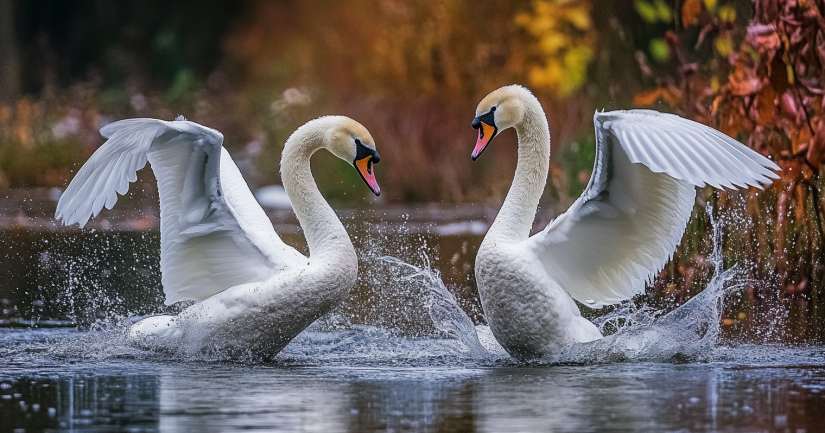
Are you ready to dive into the fascinating world of swans, This Swan Quiz is amazing. How Much Do You Know About These Elegant Waterbirds? Swans are symbols of beauty, grace, and loyalty. This Swan Quiz will test your knowledge of these majestic birds, known for their long necks, strong family bonds, and powerful flight. Found on lakes, rivers, and wetlands, swans play an important role in aquatic ecosystems. Their striking white plumage and fluid movements make them one of the most recognizable birds in the world.
Swans belong to the Anatidae family, which also includes ducks and geese. They are among the largest flying birds, with wingspans that can reach up to 3 meters (10 feet). Despite their peaceful appearance, swans are strong and territorial, using their powerful wings to defend nests from intruders.
Swans are majestic, but don’t forget to explore the sparrow in the Sparrow Quiz or the quirky seagull in the Seagull Quiz.
Discover Your Results – Begin the Swan Quiz
What Makes Swans Unique? Key Facts for the Swan Quiz
One of their most famous traits is their lifelong pair bonding. Many swans mate for life, reinforcing their connection through synchronized swimming and courtship displays. Their dedication to their partners makes them a symbol of love and devotion in many cultures.
Where Do Swans Live? Exploring Their Habitats and Migration Patterns
Swans thrive in freshwater lakes, slow-moving rivers, and marshlands. Some species, like the Mute Swan, prefer temperate regions and remain in their territories year-round. Others, such as the Tundra Swan, migrate thousands of miles between breeding and wintering grounds.
During migration, swans fly in V-formations to conserve energy. Their strong wingbeats and streamlined bodies allow them to cover great distances with minimal effort. Unlike many waterbirds, swans are also known for their vocal calls, using deep honks and whistles to communicate.
Why Are Swans Important to Aquatic Ecosystems?
Swans play a vital role in maintaining healthy wetland environments. As they feed on aquatic plants and algae, they help control vegetation growth and keep water ecosystems balanced. Their feeding habits also stir up nutrients, benefiting other aquatic life.
Their presence serves as an indicator of water quality and habitat health. Declining swan populations often signal environmental issues, such as pollution or habitat destruction. Conservationists monitor swans to assess the overall well-being of wetland ecosystems.
Are Swan Populations at Risk? Conservation and Threats
While some swan species remain stable, others face threats from habitat loss, pollution, and climate change. Lead poisoning from fishing weights and illegal hunting have also contributed to population declines in certain regions.
Conservation efforts focus on:
- Protecting wetland habitats where swans nest and forage
- Reducing pollution to improve water quality
- Preventing illegal poaching and disturbance in breeding areas
Supporting wetland conservation can help swans and many other species thrive.
Are You Ready to Take the Swan Quiz?
Now that you’ve explored the beauty, behavior, and importance of swans, it’s time to test your knowledge! This Swan Quiz will challenge you with fascinating questions about their migration, communication, and survival strategies. Can you score high on this waterbird challenge? Start the quiz now and find out!
Check out our FULL collection of Bird Quizzes!
Swan – FAQ
A swan is a large waterbird belonging to the family Anatidae, which also includes ducks and geese. Swans are known for their graceful appearance, long necks, and strong, angled wings. They are commonly found in freshwater habitats such as lakes, rivers, and marshes, primarily in the Northern Hemisphere, although some species can be found in parts of the Southern Hemisphere.
There are several species of swans, with the most notable being the mute swan, trumpeter swan, tundra swan, and black swan. Each species has distinct characteristics, such as coloration and vocalizations. The mute swan, for example, is recognized by its orange bill and is widely distributed across Europe and North America, while the black swan, native to Australia, is known for its striking black feathers.
Swans communicate through a variety of vocalizations and body language. They are known for their loud honking calls, particularly during mating displays or when defending their territory. Additionally, swans use physical gestures, such as head movements and posturing, to convey messages to their mates and rivals.
Yes, swans are typically monogamous, forming long-lasting pair bonds. During the breeding season, they construct nests near water and lay clutches of eggs, usually ranging from four to eight. Both parents participate in incubating the eggs and will fiercely protect their cygnets once they hatch, guiding them in the water and teaching them essential survival skills.
